
Side chair, Boston, Massachusetts, 1710–1720. Walnut. H. 44 5/8", W. 20 1/16", D. 21 3/8". (Courtesy, Wadsworth Atheneum of Art; photo, Gavin Ashworth.)

Ruben Moulthrop, portrait of an unknown man, New England, 1770–1790. Oil on canvas. (Courtesy, Winterthur Museum.)
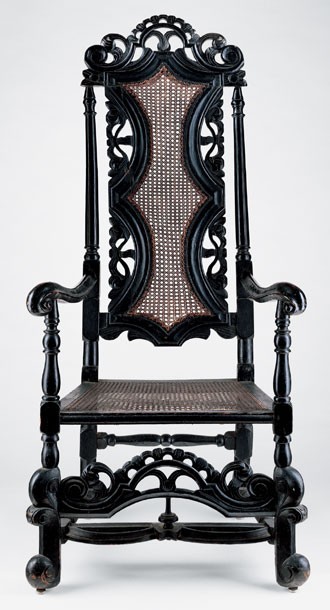
Armchair, England, 1660–1670. Beech. H. 53 1/2", W. 25", D. 22 1/2". (Private collection; photo, Gavin Ashworth.)
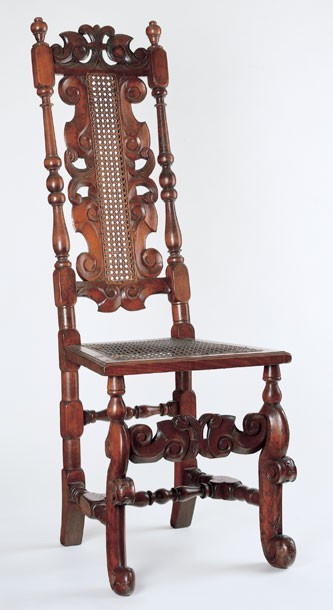
Side chair, England, 1690–1700. Beech. H. 50", W. 18 1/8", D. 19 3/4". (Courtesy, Yale University Art Gallery.)

Detail of the back of the side chair illustrated in fig. 4.

Benjamin Franklin, The Colonies Reduced, designed and engraved for The Political Register, December 1768. (Courtesy, Print Collection, Lewis Walpole Library, Yale University.) This satire of the Stamp Act attacks Britain’s mercantilist strategy of preventing the colonies from trading among themselves.
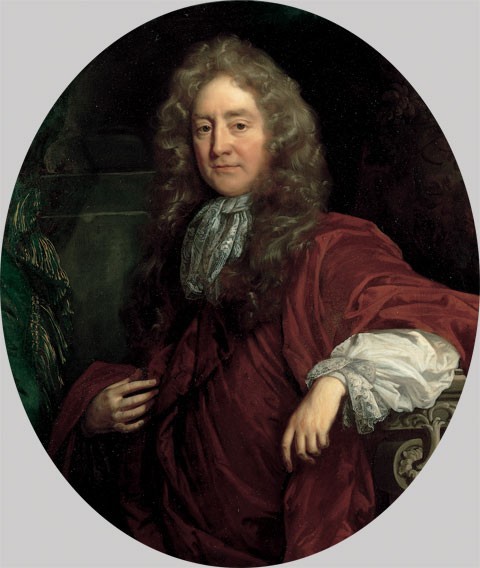
Josiah Child, attributed to John Riley, England, ca. 1680–1690. Oil on canvas. 40 1/2" x 34 5/8". (Courtesy, National Portrait Gallery.)
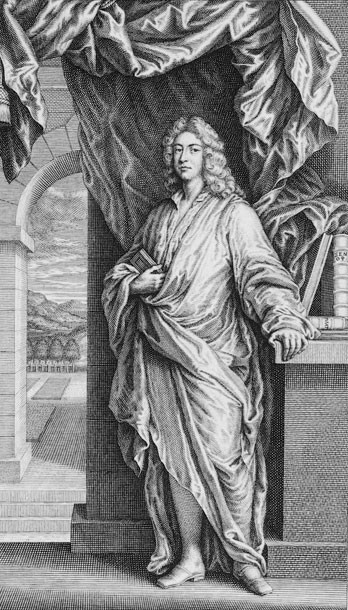
The Third Earl of Shaftesbury, engraving after a painting by John Closterman, London, ca. 1700. Ink on paper. Dimensions not recorded. (Courtesy, National Portrait Gallery.)

The First Earl of Shaftesbury, London, 1673. Ink on paper. Dimensions not recorded. (Courtesy, Print Collection, Lewis Walpole Library, Yale University.)
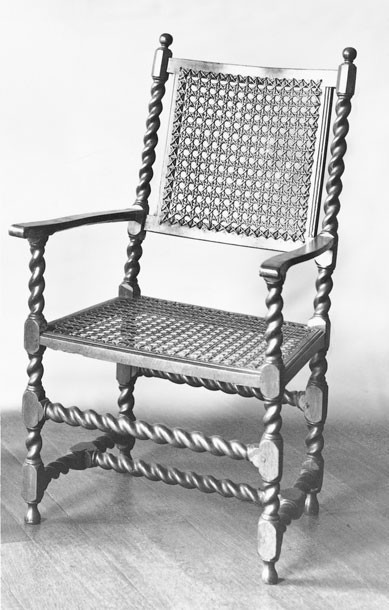
Armchair, England, 1670–1680. Dimensions and woods not recorded. (Courtesy, Winterthur Museum Decorative Arts Photographic Collection, R. W. Symonds Collection.)
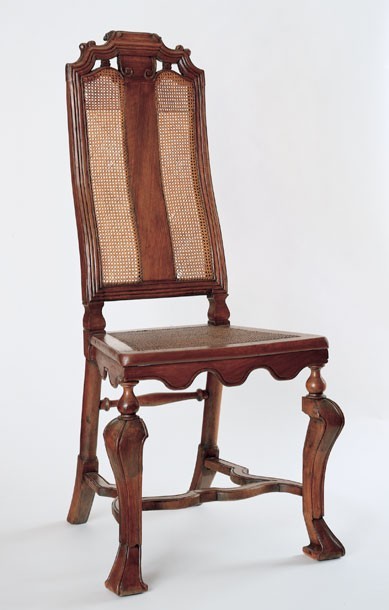
Side chair, England, 1710–1720. Walnut. H. 44 5/8", W. 20 1/4", D. 21 1/2". (Courtesy, Wadsworth Atheneum of Art, Wallace Nutting Collection, Gift of J. P. Morgan; photo, Gavin Ashworth.) The front legs have been pieced below the break in the knee.
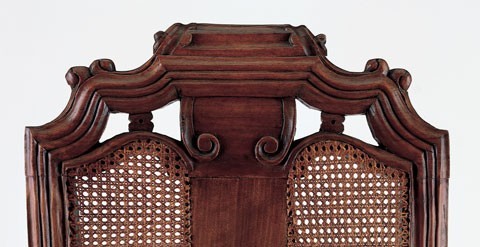
Detail of the crest of the chair illustrated in fig. 11.
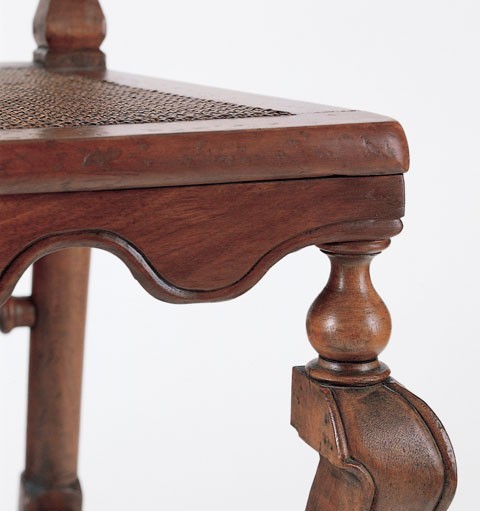
Detail of the right front leg of the chair illustrated in fig. 11.
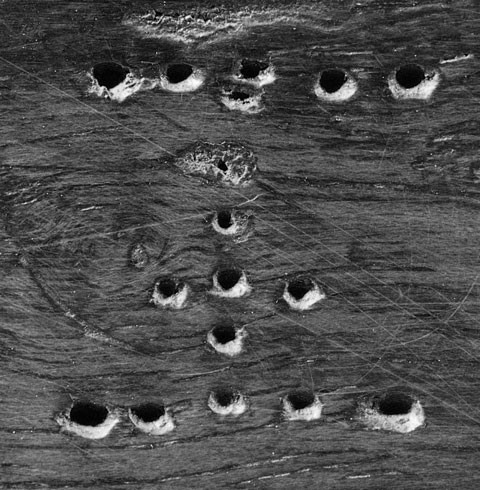
Detail of the “I” stamps on the chair illustrated in fig. 1
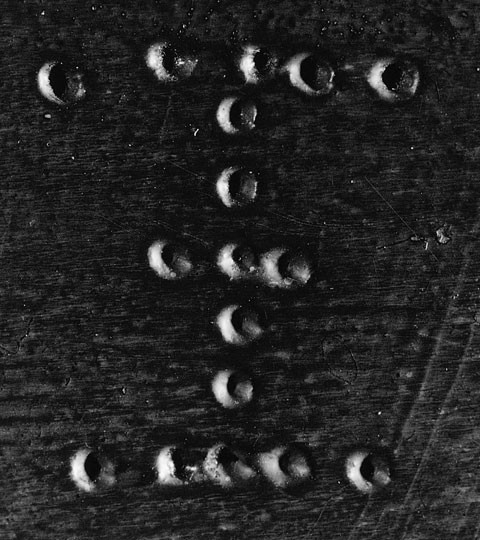
Detail of the “I” stamps on the chair illustrated in fig. 23

Detail of the “I” stamps on the chair illustrated in fig. 24

Detail of the “I” stamps on the chair illustrated in fig. 25

Detail of the “I” stamps on the chair illustrated in fig. 30

Detail of the “I” stamps on the chair illustrated in fig. 35

Side chair, England, 1685–1710. Beech. H. 51 7/8", W. 18 1/4", D. 15 1/4". (Courtesy, Winterthur Museum.)

Side chair, England, 1685–1710. Beech with pine. H. 50 1/2", W. 17 1/2", D. 20". (Courtesy, New Hampshire Historical Society.)
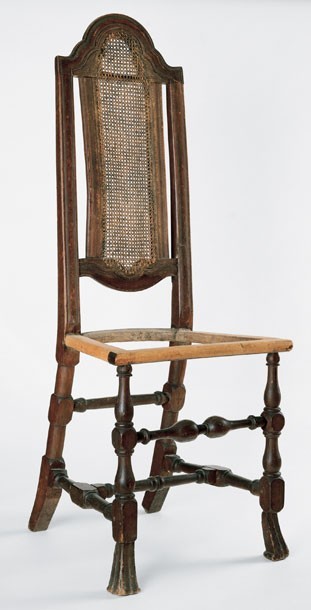
Side chair, England, 1710–1720. Beech. H. 48", W. 17 1/2", D. 14". (Courtesy Jeffrey Tillou; photo, Gavin Ashworth.)

Detail of the stamp on the side chair illustrated in fig. 17.
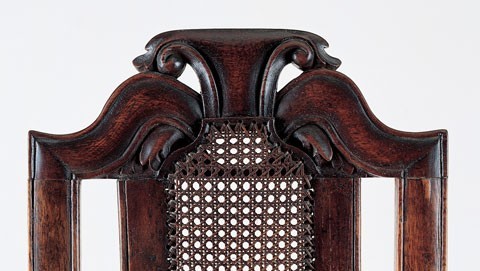
Detail of the crest of the side chair illustrated in fig. 1.
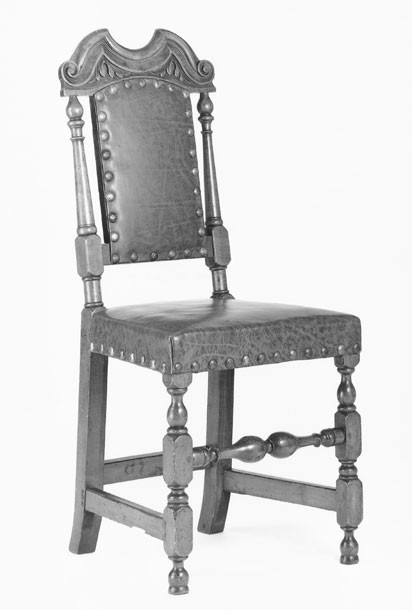
Side chair, Boston, Massachusetts, 1705–1715. Maple with red oak. H. 38 3/8", W. 17 3/4", D. 14 3/8". (Courtesy, Winterthur Museum.)
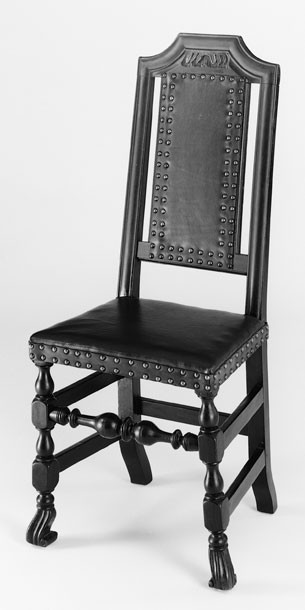
Side chair, Philadelphia, Pennsylvania, 1715–1725. Maple. H. 41", W. 18 3/4", D. 16". (Chipstone Foundation; photo, Gavin Ashworth.)
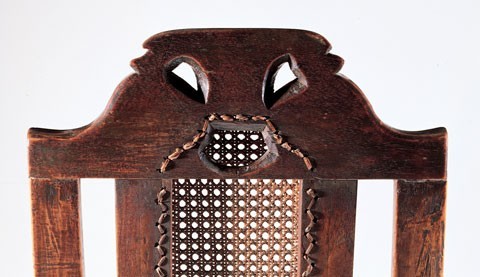
Detail showing the back of the crest of the chair illustrated in fig. 1.
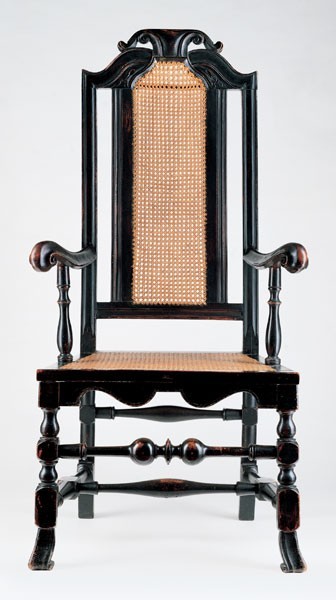
Armchair, Boston, Massachusetts, 1710–1720. Maple. H. 50 3/4", W. 23 3/8", D. 16 3/8". (Private collection; photo, Gavin Ashworth.)

Side chair, Boston, Massachusetts, 1710–1720. Soft maple with oak. H. 45 1/4", W. 18", D. 14 1/4". (Private collection; photo, Gavin Ashworth.)
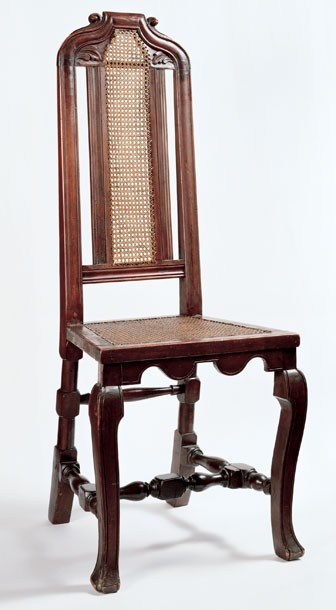
Side chair, Boston, Massachusetts, 1710–1720. Maple. H. 45 1/2", W. 18", D. 14 1/4". (Private collection; photo, Gavin Ashworth.)

Detail of the crest of the chair illustrated in fig. 25.

Side chair, Boston or Ipswich, Massachusetts, 1715–1725. Maple. H. 42 1/2", W. 18 1/2", D. 15". (Courtesy, Ipswich Historical Society; photo, Gavin Ashworth.)

Detail of the right front foot of the chair illustrated in fig. 27.
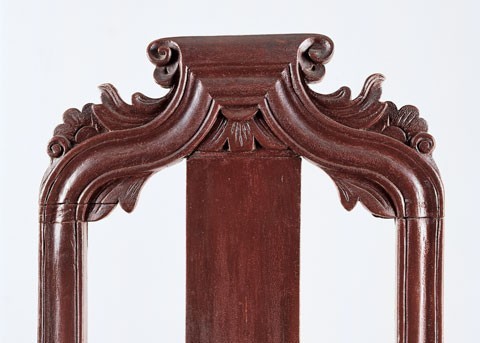
Detail of the crest of the chair illustrated in fig. 27.
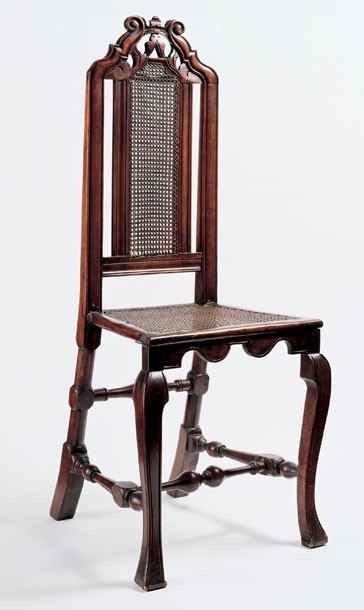
Side chair, Boston, Massachusetts, 1710–1720. Maple. H. 45", W. 17 1/2", D. 14 1/2". (Private collection; photo, Gavin Ashworth.)
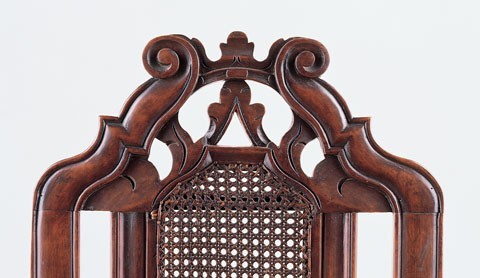
Detail of the crest of the chair illustrated in fig. 30.
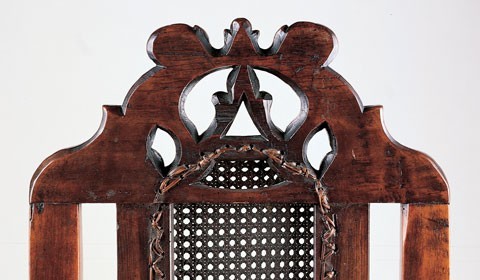
Detail of the back of the crest of the chair illustrated in fig. 30.
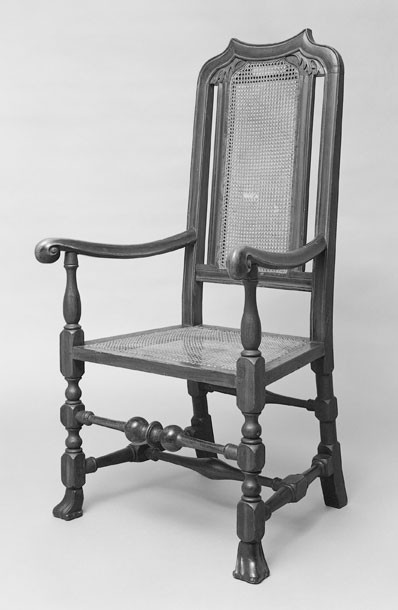
Armchair, Boston, Massachusetts, 1710–1720. Maple. H. 46 3/8", W. 24 1/2", D. 22". (Courtesy, Museum of Fine Arts, Houston; Bayou Bend Collection, gift of Miss Ima Hogg.)

Side chair, Boston, Massachusetts, 1710–1720. Maple. H. 43 1/4", W. 17 1/2", D. 14 5/8". (Courtesy, Museum of Fine Arts, Boston; gift of Mr. and Mrs. Herbert Edes.)

Side chair, Boston area of Massachusetts, 1715–1725. Maple. H. 45 1/4", W. 18", D. 14 1/2". (Private collection; photo, Gavin Ashworth.)
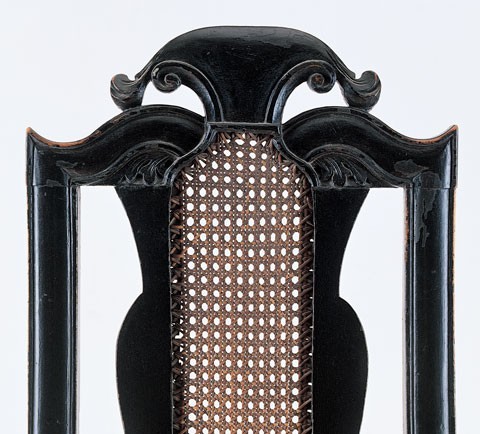
Detail of the back of the chair illustrated in fig. 35.
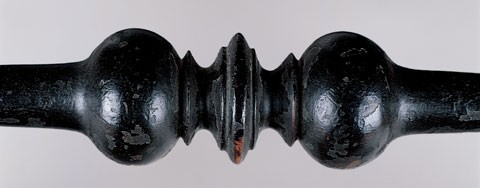
Detail of the front stretcher of the chair illustrated in fig. 35.
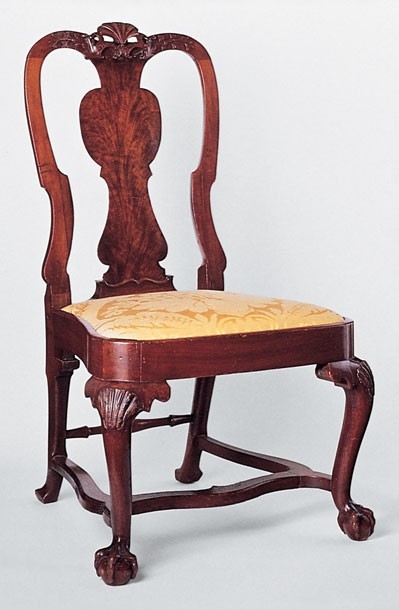
Side chair, Boston, Massachusetts, ca. 1740. Walnut and walnut veneer with maple and white pine. H. 38 1/2", W. 20 3/4", D. 18 1/2". (Chipstone Foundation; photo, Gavin Ashworth.)
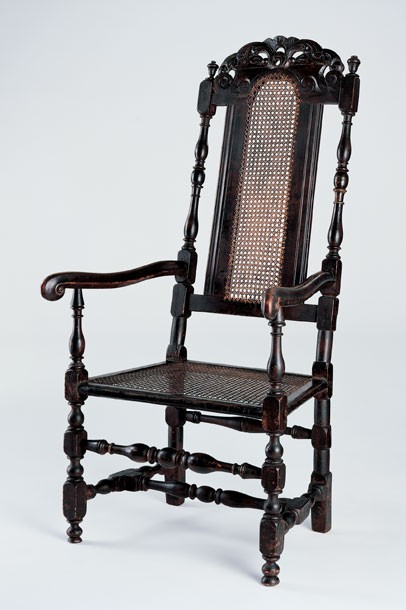
Armchair, Boston, Massachusetts, 1700–1715. Maple. H. 50 3/4", W. 25 3/4", D. 27". (Chipstone Foundation; photo, Gavin Ashworth.)
The favorite punching bag of American furniture scholarship is elitism—the historical preference for objects made for the wealthy. Yet, scholars often focus on extraordinary pieces of furniture for a good reason: because they seem to have more to say. They may have more ornament to be identified or read symbolically or a more ambitious design that may reflect a surprising degree of cosmopolitanism. Similarly, the presence of an exotic wood, textile, or brass fitting can illuminate relationships between distant locations, cultures, and economies. Too often material culture scholars assume that all objects from the past have something interesting to say about the cultural context that created them; in fact, this is not always true. One reason that historians routinely focus on the belongings of the aristocracy is that they are frequently complex, ambitious objects that have a similarly complex content. This quality of “textuality” is evident without any reference to aesthetic superiority or lack thereof, which is properly the terrain of the collector and not the historian.
An object’s value as a text can take many forms, however, and if the American furniture establishment is guilty of elitism, it is because scholars have not always searched for textual complexity in simple-looking objects. A likely subject for study in this regard is a group of approximately thirty middle-market caned chairs made in Boston in the early eighteenth century. All are related in having a mysterious punched and cross-serifed “I” mark (fig. 1). The most detailed study of these chairs is the chapter “Cane Chairs and Couches,” in Benno Forman’s American Seating Furniture, 1630– 1730. Forman was the first to attempt a comprehensive analysis of the chairs and their features and the first to identify the “I” mark as that of a caner, rather than a chair maker or owner. This article will not challenge any of Forman’s fundamental assumptions about the “I” chairs, even though several related examples have emerged since the publication of his book. Rather, it will attempt to read them as texts—that is, to place them and the style that they exemplify into a broader sociohistorical context than has previously been considered.
The Diffusion Model
The style of the “I” chairs is typically referred to as “William and Mary,” or less commonly but more accurately, “Restoration.” Both of these terms contain more than a hint of outdated assumptions about stylistic transmission. According to the diffusion model, furniture forms like the caned chair are invented for consumption among the aristocracy, only gradually trickling down to the level of popular consumption. In the process, the form undergoes simplification, losing both aesthetic value and importance as a cultural text. In the case of the American caned chair, this mechanistic story of emulation and simplification is twofold, because the form was already an imitation when the English got hold of it; they were mimicking their commercial rivals, the Dutch and the French, who actually invented the design. This narrative has some truth to it, and it is also true that the caned chair experienced drastic formal reduction in its travels. Yet this information tells us little about the historical importance of caned chairs once they reached Boston, or London for that matter. Like most furniture, the “I” chairs are the end products of cosmopolitan stylistic invention and exchange; but what makes them distinctive is their reflection of late-seventeenth-century bourgeois values in a specific place. In general, unidirectional diffusion—either downward through the class hierarchy, or centripetally from center to periphery—tells us little about the motivations of the receiving group. In a diffusion model, those who produce and consume derivative versions of a form are seen as trying to keep up as best as they can; but as British architect Colin Campbell wrote, “imitative behavior is not necessarily emulative.” The average middle-market caned chair is a good demonstration of this fact, because it embodies an intricate and specific set of class and economic concerns that are not simply imitative. It may have been derivative, but it was also the first middle-class furniture form par excellence, and thus an expression of a new way of thinking about economics and fashion.[1]
In the 1950s, British furniture historian Robert W. Symonds argued that caned chairs were first popular among the middle class who desired “cheap chairs of plain quality.” He noted that “the improving quality and increasing ornateness of cane chairs enlarged their market, and they were bought for more fashionable homes.” Symonds probably erred in arguing for a “reverse diffusion” from the middle class upwards—average and exceptional caned chairs seem to have been made side by side from the moment of the form’s introduction—but his basic intuition was correct: the makers of middling caned chairs were truly innovative. They broke with precedent in their use of craft strategies that were easily adaptable to the subtle dynamics of a mass market. A novel system of piece-work, which included easily modulated, optional details such as decorative carving, provided bourgeois patrons with a means to express developing sensibilities of display. Likewise, in helping to establish their middle-class customers’ position within a larger culture of exchange, chair makers engaged with new attitudes toward propriety, prosperity, and fashionability.[2]
The Theory and Practice of Mercantilism
First made in England in the mid-1660s, caned chairs were probably produced in vast numbers following the Great Fire of London in 1666, which created a demand unparalleled in the history of English furniture. The new form was a locus at which the various fashionable motifs of Restoration furniture converged: baroque carved decoration extrapolated from the central motif of the c-scroll; fragile construction; a lightening and exaggeration of structural form; the use of new materials including imported cane; and the gradual introduction of curvilinear elements. These features all increased over time in both high-style and middling versions of English caned chairs, with the form gradually becoming more vertical in its orientation, more flimsy in its joinery details, and more codified in its ornament (figs. 2, 3). In comparison with the simple joined chairs, forms, and stools used previously in middle-class homes, the new turned and carved caned chairs were extroverted and demonstrative. They represented a dramatic increase in what might be called the “signification value” that was available to the average furniture buyer. In adopting the marks of wealth (such as ornamental carving and fragility), but translating them into an affordable form, caned chair makers produced furniture that was primarily about symbol instead of substance.[3]
This is truer of bourgeois examples than of contemporary upper-class ones. Examination of a typical English caned chair shows the way that such middle-market work was executed in London (fig. 4). From the front, the chair looks to be respectably made. The carving is rudimentary, but attention is paid to the overall composition, as can be seen in the visual rhyme between the profile of the baluster turnings on the stiles and the c-shaped scrolls on the splat. A rear view of the chair tells a different story, however, with hastily scribed layout lines and rough edges attesting to the rapid execution of the job (fig. 5). For the makers of this chair, façade and display were clearly at a premium, even when this meant sacrificing quality in craftsmanship. This same pattern emerges in the case of most average caned chairs. They trade away the nuances of three-dimensional sculptural treatment in favor of a directed, one-point visual impact. They imply display, rather than comfort and durability, as their primary function. The question remains, though: if caned chairs were about signification, then what were they signifying?
It seems contradictory that the English would enthusiastically adopt a Dutch style of seating furniture during the 1670s at the very time they were engaged in a struggle with the Netherlands for supremacy in naval trade. (Maritime wars between the two countries [1662–1667 and 1672–1674] coincided precisely with the caned chair’s rise to prominence.) Part of the answer may lie in the demographics of the craft industry. Large numbers of French Protestant craftsmen began immigrating to England in the 1660s, many having lived in the Netherlands where they gained an understanding of Dutch styles. Immigration was particularly heavy after the revocation of the Edict of Nantes by Louis XIV in 1685, but the Huguenot diaspora had begun much earlier due to repeated prosecution and religious wars. In addition, the Rebuilding Act of 1667, passed in the wake of the Great Fire, extended generous opportunities for immigrant artificers to settle and work in London. Just as earlier generations of religiously and economically motivated immigrants had done in the 1560s and the 1630s, a wave of foreigners in the 1670s and 1680s supplied skilled labor that enabled English manufacturers to improve finished goods industries, especially textile production. Huguenots also provided labor necessary to the operation of the caned chair industry. Like immigrant workers today, their presence both boosted production and engendered resentment. English craftsmen in the Joiners’ and Carpenters’ Company railed against this foreign presence in a petition to Parliament in 1687—a complaint that signals probable depression of wages owing to the increase of skilled workmen.[4]
Without the workmanship of the Huguenots, the phenomenon of the middle-class caned chair would probably not have occurred. But even if immigrant craftsmen facilitated the caned chair industry’s expansion, they could not have been responsible for creating demand. The underlying reasons for the acceptance of the foreign-born caned chair were entirely domestic in nature and had to do with England’s desire not to emulate the commercially successful Dutch, but rather to beat them at their own game. In this sense, the caned chair can best be described not as “William and Mary,” or even as “Restoration,” but rather as “mercantilist” in style. Mercantilism was a socioeconomic doctrine that guided trade and military policy roughly from the mid-sixteenth century to the early eighteenth century. The fundamental point that drove mercantilist thought was that economic wealth and power were inextricably linked, and that a nation’s control of trade was therefore inseparable from its dominance in military and political affairs. It was English mercantilism that introduced the concept of the “balance of trade” to economics. Indeed, mercantile thinkers thought that balance of trade was the most important determinant in a nation’s prosperity, because it was the only measure of a country’s total control of the world’s wealth. Unlike later laissez faire theorists such as Adam Smith, they believed that one state’s gain in wealth necessarily meant the impoverishment of other competing states. Eli F. Heckscher, a Swedish economic historian who was the twentieth century’s most influential commentator on mercantilism, has referred to this “static conception of the total economic resources in the world” as the “tragedy of mercantilism,” because it motivated England, France, and other countries to engage in constant commercial warfare (fig. 6).[5]
Mercantilism’s emphasis on the balance of trade arose from the attempt to explain the success of England’s enemy, the Netherlands. The puzzle of Dutch prosperity was their control of commerce in finished goods despite their lack of raw materials. As one frustrated pamphleteer put it, “the exceeding Groves of Wood are in the East-Kingdomes [of Europe]: But the huge Piles of Wainscot, Clapboards, Fir-Deale, Masts, and Timber,... [are] in the Low-Countries...where none groweth.” The first systematic attempt to understand this conundrum was made in the 1620s by Thomas Mun (1571–1641), an early governor of the nascent English East India Company. Mun’s England’s Treasure by Forraign Trade (written 1628, but not published until 1664 when Mun’s son John printed it to lend theoretical support to the first Anglo-Dutch war) codified the precepts of early English mercantilism. Mun viewed the control of raw materials and currency as the main economic goal of government. He famously distinguished between “intrinsic” and “artificial” forms of wealth, the first consisting of natural resources such as land, timber, and iron, and the second of “manufactures and industrious trading with forraign commodities.” Later English merchant-economists, such as Sir Josiah Child (fig. 7), another governor of the East India Company (1630–1699), and merchant Nicholas Barbon (d. 1698), preserved and refined Mun’s distinction. Because raw materials were limited and static, they reasoned that it was only artificial wealth that could bring an increase in real prosperity. They gradually came to argue that domestic production should rest not only on the extraction of raw materials, but also on the way those materials were processed and circulated. It was this new tide in mercantilist thought that led to the infamous Navigation Acts passed by the English parliament in the 1660s. These measures were quintessential expressions of mercantilism in that they attempted to limit colonial production to the furnishing of raw materials rather than finished goods. On the domestic side, similarly, writers like Child and Barbon anxiously promoted the development of new processing industries that would add to the nation’s sources of “artificial wealth.”[6]
This focus on finished goods led quickly to the most radical and fiercely debated discoveries of late seventeenth-century economics: that middle-class novelty and fashion could be exploited as engines of commerce. The rapid overturn of production created by the vagaries of style was recognized as one of the secrets of Netherlandish wealth. Child wrote in the 1660s that the success of the Dutch was due in part to “their giving great incouragement and immunities to the Inventors of New Manufactures.” During the 1670s and 1680s, English writers praised the salutary effects of domestic imitation of stylish imports. John Houghton noted in 1677 that French goods “have set us all a-gog, and have encreas’d among us many considerable trades,” whereas Dalby Thomas wrote that imported luxuries were “true Spurs to Virtue, Valour and the Elevation of the Mind,” and more importantly, grist for the fashion mill. It is important to distinguish, however, between three distinct types of import: the borrowing of styles, the immigration of craftsmen, and the actual importation of finished goods. Mercantilist ideas about the balance of trade still held enough sway to encourage the acceptance of foreign ideas and skilled workers but not commodities themselves. One writer argued that England’s cause should be advanced “by our own Art and Industry, bringing in whatever Foreign Arts, Trades or Husbandries may be profitable to us.” By supplying “ourselves within ourselves,” he wrote, “we need few Foreign things, and make as many Commodities at home as possible.” John Houghton, similarly, endorsed the immigration of workmen, such as the Huguenots who enhanced the furniture and textile trades. Although Houghton “could wish there would 20,000 [artificers] come in next year,” he welcomed only the importation of unfinished goods such as Scandinavian timber. The fashion for the foreign could be seen positively only if other nations could be tapped for marketable ideas and able workers without threatening domestic manufactures.[7]
The Caned Chair as an Expression of Mercantilism
In this context, it is easy to understand how the English caned chair reflected prevailing ideas about production. Insofar as it was adapted from Dutch stylistic sources, the caned chair was an example of competition in action. If the English could make their own stylish chairs, they did not need to import any from the Netherlands. Furthermore, the caned chair’s novelty, its emphasis on display, and its impermanence all made it both an example and a stylistic expression of “artificial wealth.” Unlike previous middle-class seating furniture, the caned chair declared its status as a commodity. Its quick and expedient carving would have gratified contemporary preferences for finished goods without making the chairs unaffordable. Its fragile construction—a kind of seventeenth-century planned obsolescence—underscored the fact that it was a fashionable object, not just a serviceable one. In both its style and its method of construction, the caned chair was an appropriate expression of currents in mercantilist theory.
A parliamentary petition written by the Joiners’ Company in 1688 suggests that caned chair makers thought of their products in precisely these terms. Discovered and published by R. W. Symonds in 1951, this document was written as a rebuttal of a petition from the textile manufacturers of the town of Bradford proposing the suppression of caned chair manufacture, which had brought about a rapid decline in the demand for upholstery. The textile merchants had complained:
Since Cane chairs, stools and couches, which generally the frames are made of French Walnut, and the Seats of Indian Canes, are become so much in use; the Consumption of Wool is greatly decreased; and above 50,000 of his Majesties Subjects formerly employed in the Manufactury thereof, have lost their Employment, to the Ruine of them and...[their] numerous Families.[8]
There are several interesting aspects to the case of the Bradford textile merchants and the mercantilist precepts that motivated it. First, the foreign origin of the caned chair is emphasized, particularly that of its materials (“French walnut” and “Indian canes”). This was problematic from the perspective of mid-seventeenth-century economic theory, which held that the balance of trade in raw materials was the key to national prosperity. Second, the document explicitly recognizes the field of general consumption as a vital site of competition in its statement that caned chairs are “so much in use,” or by inference, more popular than upholstered chairs. This amounted to a tacit awareness that fashions among the general populace could be economically significant. Third, the argument for the suppression of caning rests on the livelihood of people employed in the production of wool. As a non-crafted good, most wool workers were involved not with finishing the material but producing it. In this sense, the argument lodged against the Joiners’ Company was that an industry that focused on raw material production was suffering at the hands of an industry that consisted entirely of processing.[9]
In responding to these charges, the Joiners’ Company went beyond a simple refutation of the facts of the case, instead engaging the textile merchants within the terms of contemporary mercantilist theory. Their petition to Parliament argued that caned chairs in fact had come to make up a substantial part of the English economy:
Before Cane-Chairs, Stools, Squobs and Couches were made in England, there was not (according to the largest Information that can be gathered) above One hundred and eighty Persons employed in Making and Turning of Chair-Frames to be covered in Turkey-work, Serge, Camblets, Kidderminster, and other Stuffs of Woolen Manufacture; there being but little work in the Making, less work in the Turning, and generally no carving at all in the Frames....[caned furniture] gave so much Satisfaction to all the Nobility, Gentry, and Commonality of this Kingdom...that they came to be manufactured in England, and sent to all parts of the World; which occasioned the Chair-Frame Makers and Turners to take many Apprentices; and Cane-Chairs, &c. coming in time to be carved, many Carvers took Apprentices, and brought them up to the Carving of Cane-Chairs, Stools, Couches and Squobs only. And there were many Apprentices bound only to learn to split the Canes, and Cane those Chairs, &c. And as the Trade for Cane-Chairs, &c., increased, the People bread [sic] up in the several Trades depending upon them also increased, their Number being (upon a true Survey) found to be at this day many Thousands of People, many of whom pay very great Rents, and have long Leases of Houses, taken purposively to Make and Sell Cane-Chairs.
Interestingly, there is no mention of what is ostensibly the textile manufacturers’ most damning argument: that chair makers’ dependence on foreign materials is bad for the English populace. The Joiners’ Company could, for example, have mentioned the common use of domestic English beech in caned chair manufacture.[10]
Instead, the Joiners’ Company stressed the fact that England was able to gain what Mun would have called artificial wealth by sending chairs “to all parts of the World,” thus helping achieve a favorable balance of trade. Furthermore, they directed attention toward the turning and carving that went into the furniture (unlike upholstered chairs which necessitated “little work in the Making”) and the training of apprentices who provided the semi-skilled labor to cane the chairs. The Joiners’ Company also pointed out that high demand for workmanship and rapid change translated into jobs for numerous skilled craftspeople. The caned chair was, according to this view, to be valued precisely for the employment provided by the process-intensive character of the industry—a textbook case of “artificial wealth” translating into general prosperity. Indeed, two years after the Joiners’ Company’s petition, mercantilist theorist Nicholas Barbon noted that fashionable products such as chairs helped to boost the economy:
The Shoo-makers, Saddlers, Coach, and Chair-makers [provide] with abundance more for the Ease of Life....Thus Busie Man is imployed, and it is for his own Benefit; for by Trade, the Natural Stock of the Country is improved; the Wool and Flax, are made into Cloth; the Skins, into Leather; and the Wood, Lead, Iron and Tin, into a thousand useful Things.[11]
The interest that the later mercantilists showed in the “ease of life” fostered by the luxury trade—an area of production that had once seemed marginal to the economy—was a turnabout from the policy and economic theory of the pre-Restoration era. As the seventeenth century progressed, it became increasingly clear that processing materials was often more profitable than producing them. Rural and urban manufacturing projects gained momentum, and the quality of English-made luxury goods began to rival that of foreign nations. The social freedoms of the Restoration era made the advantages of finishing goods even more apparent, as the sumptuary laws of the Elizabethan and Jacobean periods and the imposed restraint of the interregnum were overturned. Rural households increasingly bought finished goods instead of fashioning every necessity at home. Having seen these changes, economic theorists concluded that it was not only the rich whose consumption could be turned to advantage. As Dudley North wrote in 1691, “The main spur to Trade, or rather to Industry and Ingenuity, is the exorbitant Appetites of Men...for did Men content themselves with bare Necessities, we should have a poor World.” Bernard Mandeville’s comments in The Grumbling Hive (1705) were even more pointed. He wrote that “frugality...[is] an idle dreaming Virtue that employs no hands, and therefore very useless in a trading country, where there are vast Numbers that one way or another must all be set to Work.” On the contrary, “Fickleness in Diet, Furniture and Dress, that strange ridic’lous Vice, was made the very Wheel that turn’d the Trade.”[12]
Good Taste
The sanguine attitude with which economists first met the popularity of foreign styles and the pretensions of the bourgeoisie was not universally shared, however. As the 1690s progressed, protectionism and xenophobia reared their heads increasingly under the double pressures of crushing war debt and domestic currency shortages. In 1700, Daniel Defoe criticized such attitudes with typical wit: “Tis worth observing, that we ne’er complain’d of foreigners, nor of the Wealth they gain’d, till all their services were at an end.” But by this time, few economists were inclined to agree. Commentary on the luxury trade acquired a tinge of moral repugnance, and extravagances welcomed by economists in the 1670s and 1680s became increasingly suspect. The economic benefits of “outvying” the middle classes were disregarded, and writers grew increasingly fearful of social misrepresentation and the unpredictable consequences of blurring “natural” class boundaries. Novelty itself came under assault in this elitist backlash. Protestant religious groups, who had long opposed luxury, took the lead in criticizing those who put on airs. Quaker reformer John Bellers, for example, characterized the unpredictability of the luxury trade as destructive to a rational, well-planned economy. The rapid turnover of styles, he argued, made it impossible to maintain consistent employment: “The uncertainty of fashions doth increase our Necessitous Poor...a Voluptuous Age may easily fall into excess, with dress and pleasure, by [that which is] Ornamental and Delightful.”[13]
Moral indignation directed against the improper display of affluence went far beyond the convictions of religious sectarians. A distrust of showy luxury goods was widely held by the turn of the century, most famously by the aesthetic philosopher, Anthony Ashley Cooper, the third Earl of Shaftesbury (1671–1713) (fig. 8). A pupil of John Locke, Shaftesbury became the foremost turn-of-the-century aesthetic philosopher in England and helped formulate a theory of taste that was antithetical to late seventeenth-century notions of middle-class fashionability. He argued that the appreciation of beauty transcended the realm of common sense and that taste was a learned faculty rather than an instinctive one. Consequently only an educated, polite gentleman could grasp proper aesthetic and ethical standards. Such “virtuosi,” Shaftesbury claimed, were capable of the disinterest necessary for accurate aesthetic judgment. Nor was Shaftesbury alone in his opinions. The great essayist Joseph Addison explicitly compared aesthetic sensibility to the ownership of property by a gentleman: “A Man of a Polite Imagination is let into a great many Pleasures that the Vulgar are not capable of receiving. He can converse with a Picture, and find an agreeable Companion in a Statue....It gives him, indeed, a kind of Property in every thing he sees, and makes the most rude uncultivated Parts of Nature administer to his Pleasures.”[14]
The development of an aesthetic based on elitist concepts of taste had important consequences for the development of English luxury goods, including furniture. A sense of the rapid stylistic change can be gotten from a comparison of Shaftesbury’s portrait (fig. 8) with that of his grandfather, the first Earl of Shaftesbury (fig. 9). The first earl (1621–1683) had been one of the most convinced and effective mercantilist politicians in the early years of the Restoration and held the position of president of the Board of Trade during the 1670s. He was also involved in a variety of private commercial pursuits, including the Royal African Company and the Hudson Bay Company. A caned chair owned by the first earl (fig. 10) is typical of examples made during the 1660s or 1670s in having a short back, boxy proportions, and limited carving. It is unlikely that the third Earl of Shaftesbury would have considered purchasing an example like this one given his aesthetic preferences. An up-to-date chair would have suited his taste much better, particularly during the later years of his life (figs. 11-13). Indeed, one of Shaftesbury’s lists of the properties of polite deportment could just as well apply to the differences between the two chair forms: “mobility rather than stiffness, informality over formality, openendedness rather than over-determination and dogmatism, conviviality rather than solemnity and gravity.” One can see how Shaftesbury’s aesthetic values directly challenged those of the previous generation. Chairs in the new Georgian idiom featured fluid lines, a sculptural and “openended” composition, and a lower, more “informal” and “convivial” back height. All of these features were implicit rejections of the caned chair’s rigid array of vertical elements. Shaftesbury would no doubt have found his grandfather’s chair “stiff” and “dogmatic.”[15]
The early Georgian chair carried more than a superficial relationship to Shaftebury’s rhetoric of taste. No longer was there a vocabulary of display that could, as simply as an appliqué, be transported to chairs for any market level. Although caned chairs incorporate curvilinear elements, these details are isolated from each other so that legs, stretchers, and seats can be made separately through a system of piece-work. This seventeenth-century compartmentalization of workmanship allowed chairs to accommodate different levels of consumer investment without losing a basic sense of display. The early Georgian chair, by contrast, is an all or nothing proposition requiring subtle modeling to unify the shape so all of the curved surfaces resonate with each other and transition gracefully to the seat frame. Some of the piece-work systems that had been a mainstay of middle market Restoration design remained in place, but others disappeared or changed to meet the exigencies of the new taste. Furthermore, in the early Georgian style there is no variable equivalent to the differences in carving which distinguish different levels of the caned chair market. When carved decoration is added to the form, as in the first Georgian-style chairs made in Boston during the onset of the style in America, it feels disjunctive with the rest of the composition. In a caned chair, the carving on the crest (and often a matching front stretcher) is manifestly the point—the formal gesture for which the rest of the object is but an armature. In this regard it is a perfect middle-class form. The early Georgian chair, on the other hand, simply makes no sense when executed below a certain level of time, care, material investment, and skill. This is not to say that the onset of Georgian styles suddenly deprived the middle classes of furniture, since consumers at that level continued to purchase and use caned chairs and their derivatives. Rather, the new seating forms embraced by the gentry and the nobility were intentionally distinguished from those of the lower ranks by a barrier of taste and affordability.
The Caned Chair in America
In England, the correlation between the early Georgian style and elite notions of politeness serves to mark the close of the caned chair’s moment of cultural currency. But in America, the inception of the caned chair actually post-dated both the writings of Shaftesbury and the momentous turn-of-the-century shifts in furniture design. The results can be seen in the group of Boston chairs mentioned at the beginning of this article. Traditionally the central point of debate about these objects is the meaning of the punched “I” that they bear on their backs—some on the rear face of the left stile, and some on the left end of the lower stay rail of the back (fig. 14). Benno Forman convincingly argued that this is a caner’s or caning shop’s mark for a variety of reasons, including the fact that there are no leather-upholstered chairs with the mark (as one would expect if this were the mark of a frame maker), and the impossibility of so many unmatched chairs belonging to a single family (which eliminates the possibility that this is an owner’s mark, as Richard Randall had argued in 1965).[16]
Today it is possible to make an even stronger case for Forman’s interpretation of the mark, because at least two of the chairs bearing it appear to be English. One was thought by Forman to be American on the basis of wood analysis conducted in the 1970s (fig. 15). Regrettably, the accuracy of these tests has been widely discredited since it is currently impossible to distinguish between American and English species of beech. In the absence of such evidence, there is no reason to believe that the chair illustrated in figure 15 is anything other than a standard, middle-market English example. In addition to the fact that this chair looks English, its stamped mark “IP” is similar to that on an English chair in the New Hampshire Historical Society (fig. 16). Furthermore, the chair shown in figure 15 has a virtual mate with a different mark and a history of having been imported from England in the mid-1680s by the Winthrop family. In all probability, the mark on the chair illustrated in figure 15 was made when the chair was re-caned some fifty years after it arrived in New England.[17]
The theory that the “I” refers to a caner or caning shop is also bolstered by the character of the marks, which do not have the professional quality one might expect from a joinery shop. Although the execution of the “I” marks varies, implying a number of different hands, all are punched rather than stamped or branded like most owners’ marks on furniture of the period. Other caned chairs with punched letters or symbols are known, however (figs. 17, 18). The shallow, round indentations comprising these marks may have been made with a common caning tool. Caners typically used small metal styluses to push the cane through holes, particularly those with more than one strand running through them.[18]
Regardless of the meaning of the punched “I,” the mark serves to group these chairs in time and space. All were either made or present in Boston between about 1710 and 1725. The Boston examples display a remarkable degree of stylistic conformity, most incorporating features derived from London caned chairs of the 1690s as well as early Georgian chairs of the 1710s. Although it is possible that many of these chairs are from the same shop, the structural shortcuts and piece-work systems that developed to support Boston’s leather chair manufacturing and export business contributed to the standardization of design. Specialists such as carvers and turners sold similar components to different chair makers who produced assembled frames for local clients as well as merchants and upholsterers engaged in the coastal trade.
All of the Boston chairs have turned undercarriages with similar front, medial, and rear stretchers. The stretcher configuration on the chairs comes in two versions, one with the medial stretcher joined into the side stretchers at their midpoint, and the other with the medial stretcher shifted towards the front of the chair. Forman thought the latter configuration to be later because of its use in Boston Georgian seating, but this can be neither proved nor disproved. Most Boston caned chairs have turned front legs with “Spanish” or tassel feet, or square “unwrought” cabriole legs. Again, one would like to believe that the cabriole legs indicate a later date within the overall sequence of the group, but it could well be that this was simply an interchangeable feature. When turned, the legs conform to one of two patterns, distinguishable by the degree of elongation in the upper vase turning. Most if not all of the chairs had shaped aprons attached with nails (see fig. 1), though most have been lost. A few examples have similar aprons on the side rails, but this does not appear to have been a common feature. Most crucially, all of the “I” chairs have molded stiles that move fluidly into the crests, showing that the shop or shops that produced them had some awareness of early Georgian composition.
The crests of the “I” chairs display more variation than any other component, but a degree of uniformity is evident. All of the crests have shallow, carved leaves in the lower corners of the design, and all have carved edge beads that intersect the planed beads on the stiles (fig. 19). These signature elements link all of the Boston chairs stylistically. The style and basic composition of the carving, which is similar to that on several unmarked, Boston caned chairs, has precedents in earlier low-backed, leather chairs (fig. 20). Somewhat later, Philadelphia chair makers used similar motifs (fig. 21), probably in an effort to compete with fashionable Boston imports.[19]
Apart from the leaf carving and edge moldings, the crest patterns are quite different from each other. The most common variant has a foliate spray that extends upwards from the middle of the crest (see figs. 1, 19). Often the points of intersection between this element and the other parts of the crest are small, leaving very little wood to hold the top of the chair together (fig. 22). Perhaps owing to this fragile design, chair makers occasionally left a “bridge” of wood on the lower, rear edge of the crest. This feature provided additional support to resist the torque and stress of the caning process and subsequent use. Two of the three extant armchairs in the “I” group have foliate sprays and unusually short arms that rest on supports joined directly into the middle of the side seat rails (fig. 23). As is the case with later Georgian armchairs, they are broader in seat width than the side chairs in the group.[20]
The second most common type of crest, which occurs on at least five of the “I” chairs, is clearly derived from late English caned chairs (fig. 24). This design features a squared-off top that is connected to the stiles by sinuous molded serpentine shapes. Decorative carved volutes, either two or four in number, articulate the upper edge of these crests. Like the first crest pattern (see figs. 1, 12), this variant sometimes has a strengthening bridge in the back. It bears a strong visual relationship to both of the other crest designs, particularly the one with a central foliate spray, but in many examples it is carved in a summary fashion. The sloping planes of the front of the crest are often choppy, and the carved leaves are reduced to nearly illegible stubs. In these crests the rapidity of manufacture is obvious, and such chairs were no doubt produced in large numbers. There are versions of this same crest pattern on many Boston area chairs outside the “I” group.
Two caned chairs with squared-off crests have leaf elements that were outlined, modeled, and shaded more professionally than those on other chairs in the group. The example shown in figures 25 and 26 has two small leaf clusters with carefully regulated shading cuts. This work may be a precursor to the linear acanthus carving found on two of the earliest Boston Georgian chairs. The most ornately carved of the chairs related to the “I” group (fig. 27) is not caned at all, but it seems to represent the apotheosis of the Boston style. The chair appears to have been made in that city or in nearby Ipswich, Massachusetts. With its shaped stretchers, collared cabriole legs (fig. 28), and Chinese banister, this object may be slightly later than the “I” chairs. It does, however, preserve the basic form of the “I” chair crests. The signature leaf carvings are present, but they are more naturalistic and complex than those on any “I” chair (fig. 29). If the chair illustrated in figure 27 is an Ipswich product, it may well be from the Gaines family shop, which frequently adapted and amplified designs from Boston-area products.[21]
The third crest found on the “I” chairs is the most complex, with molded cyma elements terminating in bold scroll volutes, multiple leaf elements outlined by piercings, and flat planes decorated with small carved panels and chip cuts (figs. 30, 31). This is an extraordinarily fragile design, and like the two most common crest patterns, it is held together with a bridge of wood at the lower, back edge of the crest (fig. 32). In terms of the overall handling of the carving, this crest type stands apart in its contrast of strong graphic and fussy passages. The carving is also flatter and less refined than that seen on most of the other chairs. It is likely that these chairs represent the work of a different carver or even a different shop than the other “I” group chairs.
The fourth and fifth crest patterns are rare, one appearing on two chairs (fig. 33) This yoke or saddled crest has no decoration other than simple leaf carving; however, this work is less perfunctory than that found on many “I” chairs. The final and most idiosyncratic crest occurs on a single chair that descended in the Edes family of Boston (fig. 34). This design has the vestigial leaves of the other patterns and the intact “bridge” of wood in the back, but otherwise stands apart from the rest of the group.
The structural and stylistic features of the “I” group and its relatives indicate that Boston chair makers adopted the tricks of the middling London trade. At first one would think that the chairs are the confused products of makers who were operating with an imperfect understanding of the new Georgian style. With two exceptions, the stiles of the chairs are straight from seat rail to crest, so they could be made simply by preparing a straight piece of lumber and then running a molding down each side. One of the “I” chairs that does have cyma-curved stiles also features a “crook’d,” vasiform splat, and the other is made of walnut, suggesting a more mature awareness of Georgian design and perhaps a later date than the other chairs in the group (figs. 35-37). Even these two chairs lack the overall compositional unity that Shaftesbury and his generation prized; for that, Bostonians would have to wait a decade or more (fig. 38). Yet it is not a coincidence that the early Georgian features that appear on the chairs—notably molded stiles and square cabriole legs—are neither time-consuming to execute, nor disruptive to an established tradition of piece-work manufacture. In this respect, the makers of the chairs should be seen, like English caned chair makers before them, as canny artisans who were able to adapt new stylistic features without disrupting their own profit margin and way of working.
The “I” chairs clearly occupy a complex position in furniture history. They are structurally simple objects, but extremely complicated texts. The chairs reflect some of the same cultural preoccupations that spurred the popularity of the caned chair in England in the 1670s even though the “signifying” crest is the only salient compositional feature surviving from the earlier forms. The “I” chairs also have little in common with the first generation of Boston caned chairs (fig. 39), which, like most seminal seating forms produced in that city, were more direct transpositions of London models.
In many respects, the “I” chairs can be interpreted as descendants of early Boston leather chairs, which performed the same role for that city’s trade that the caned chair had played in London. As historian Neil Kamil has shown, the leather chair was part of a conscious and ultimately successful attempt to right Boston’s own balance of trade. Although New Englanders could not compete with the staple producing colonies to the south, they could produce furniture and other finished goods that would give them a favorable balance of trade with the Middle Atlantic. This strategy was obviously based on the more entrenched mercantile system of the mother country.[22]
Against this backdrop, it is possible to find in the “I” chairs more than an example of a shift toward Georgian style. Their part in this broad stylistic trend is undeniable, but it is also clear that the “I” chairs were perfect symbols of an even more large-scale attempt to transform the symbolic culture of the mercantile class. By combining the carved crests of the English caned chair and Boston leather chair with nascent Georgian features, the “I” chairs crystallized the mentality of Boston’s upwardly mobile commercial elite. In this sense the chairs mark the transition between what might be called the “mercantilist style” and a new concept of taste and fashionability. Though culturally severed from the elitism of Shaftesbury and his contemporaries, they are nonetheless structurally consonant with that elitism. All of the examples with credible provenances descended in families of the upper class including the Hancocks, Holyokes, and Aldens. These seating forms mark the appropriation by such civic leaders of competitive tactics that had put Londoners at the center of that empire. And like the Georgian style in England, they mark the end of those tactics’ efficacy. From the 1710s to the 1740s, Boston was the most important center of the American carrying trade, and its merchants grew wealthy through commerce with the West Indies. This elite identified strongly with the English monarchy and was instrumental in transforming New England into a class-conscious society. As in England, the government’s role in the economy was reimagined, and the theocracy of the seventeenth century gave way to a more instrumental oligarchy that tried to foster the success of trade. Given the presence of this upwardly mobile clientele, it was only logical that Boston chair makers embraced the same strategy that guided their London counterparts thirty years before. It is ironic that so much scholarly effort has been expended on reading the inscrutable “I” marks on these chairs, when those marks were not intended to be highly legible. To read these chairs as texts, we need to pay the most attention to the areas where the makers invested the majority of their skill and labor—the crests, which were the site of greatest visual impact. After all, the chairs were not so much fashionable as representations of fashionability itself. In this respect, they bespeak conscious participation in the larger world of English mercantilism, in which membership in the middle class was more a matter of assertion than taste.[23]
ACKNOWLEDGMENTS
The author thanks Gavin Ashworth, Luke Beckerdite, Ann Bermingham, Edward S. Cooke, Jr., Tom Denenberg, Janet Deranian, Bert Denker, Eleanore Gadsden, Constance and Dudley Godfrey, Charles Hummel, Alan Miller, Jonathan Prown, Robert F. Trent, Maria Theresa and John Van Der Sande, Anne and Fred Vogel, and Alicia Volk.
For characteristics distinguishing Dutch chairs from English derivatives, see Adam Bowett, “Myths of Furniture History: Anglo-Dutch (Part II),” Antique Collecting 34, no. 8 (February 2000): 4–9. Colin Campbell, “Understanding Traditional and Modern Patterns of Consumption in Eighteenth-Century England: A Character-Action Approach,” in Brewer and Porter, Consumption and the World of Goods (London: Routledge, 1993), p. 40. See also Lorna Weatherill, Consumer Behaviour and Material Culture in Britain 1660–1760 (London: Routledge, 1988); Weatherill argues that “If social emulation were at work as a dynamic force behind people’s motivation in owning goods, then we would expect higher proportions of the most highly regarded group to own many [items], and we would also expect them to be the first to own the new things. Yet...this was not the case, for a higher proportion of professionals and tradesmen owned the goods associated with front stage areas of the house” (p. 195). For a more general objection to diffusion models on theoretical grounds, see Dell Upton, “Towards A Performance Theory of Vernacular Architecture: Early Tidewater Virginia As a Case Study,” Folklore Forum 12, no. 2/3 (1979). Benno M. Forman, American Seating Furniture, 1630–1730: An Interpretive Catalogue (New York: W.W. Norton for the Winterthur Museum, 1988), pp. 229–81.
R. W. Symonds, “English Cane Chairs: Part I,” Connoisseur 27, no. 3 (March 1951): 8.
Symonds, “English Cane Chairs: Part I,” p. 8. Since Symonds’ analysis in the 1950s, Peter Earle has questioned the importance of the Great Fire in initiating cane chair manufacture. In his analysis of middle-class estate records, the form appears only rarely in the 1670s and does not become common until the 1680s. This may, however, simply reflect a time lag between the introduction of the form and its appearance in the inventories of decedents, who might have owned the chairs for some time before the furniture came to be recorded. See Peter Earle, The Making of the English Middle Class (London: Methuen, 1989), p. 294.
Irene Scouloudi, “The Stranger Community in the Metropolis, 1558–1640” in Scouloudi, Huguenots in Britain and Their French Background (Basingstoke, Eng.: Macmillan Press, 1987), pp. 48–49; Penelope Corfield, “A Provincial Capital in the Late Seventeenth Century: The Case of Norwich,” in Crisis and Order in English Towns, edited by Peter Clark and P. Slack (London: Routledge and Kegan Paul, 1972), p. 282; Christopher Hartop, The Huguenot Legacy: English Silver 1680–1760 (London: Thomas Heneage, 1996). Jonathan Israel, “England, the Dutch, and the Struggle for the Mastery of World Trade in the Age of the Glorious Revolution,” in The World of William and Mary, edited by Dale Hoak and Mordechai Feingold (Stanford: Stanford University Press, 1996), p. 75. Bernard Cottret, The Huguenots in England (Cambridge: Cambridge University Press, 1985), p. 198.
Eli F. Heckscher, Mercantilism, 2 vols. (New York: Macmillan, 1955), 2: 25–26.
John Keymer, A Clear and Evident Way [1650], quoted in Joyce Appleby, Economic Thought and Ideology in Seventeenth-Century England (Princeton: Princeton University Press, 1978), p. 76. On Mun, see Kustaa Multamäki, Towards Great Britain: Commerce and Conquest in the Thought of Algernon Sidney and Charles Davenant (Helsinki: Finnish Academy of Arts and Letters, 1999), p. 83 V.; Jules Lubbock, The Tyranny of Taste (New Haven, Conn.: Yale University Press, 1995), pp. 93–94; Michael Kammen, Empire and Interest: The American Colonies and the Politics of Mercantilism (Philadelphia: J. P. Lippincott, 1970), pp. 5–6; and Heckscher, Mercantilism, 2: 281–82. Thomas Mun, England’s Treasure by Forraign Trade (London: Thomas Clark, 1664; written 1623), p. 15. On the effects of the Navigation Acts on the colonies, see Susan Previant Lee and Peter Passell, A New Economic View of American History (New York: W. W. Norton, 1979), chapter 2. For contemporary arguments about the importance of finished goods, see Dalby Thomas, An Historical Account of the Rise and Growth of the West-India Colonies (London: Joseph Hindemarsh, 1690), p. 5; Appleby, Economic Thought and Ideology, chapter 7, passim.
Sir Josiah Child, A Discourse About Trade (London: A. Sowle, 1690; written 1660s), p. 4. John Houghton, England’s Great Happiness, or, A Dialogue Between Contentment and Complaint (London: Edward Croft, 1677), p. 5; Thomas, An Historical Account of the Rise and Growth of the West-India Colonies, p. 16. Carew Reynel, The True English Interest (London: Giles Widdowes, 1674), preface 4; p. 2. Houghton, England’s Great Happiness, pp. 5, 10.
Quoted in Symonds, “English Cane Chairs: Part I,” p. 12. For further discussion of this document, see Margaret Swain, “The Turkey-work Chairs of Holyroodhouse,” in Upholstery in America and Europe from the Seventeenth Century to World War I, edited by Edward S. Cooke, Jr. (New York: W. W. Norton, 1987), pp. 54–55.
The rattan or cane used in such chairs might have come from a variety of sources, as the plant is native to China, India, Ceylon, and Malaysia. In all likelihood the canes used in English shops were bought from Dutch or Portuguese middlemen. On cane, see Gertrude Z. Thomas, Richer Than Spices (New York: Alfred A. Knopf, 1965), chapter 5; and Encyclopedie Methodique, Tome Quatrieme (Paris: Chez Panckouche, 1785).
Symonds, “English Cane Chairs: Part I,” pp. 13–14. The Joiners’ Company’s claim that “many thousands” of workers benefited seems dubious, but it is a figure substantiated by modern research. Peter Earle notes that “several thousand” people were employed in the furniture trade in London alone, concentrated in the area north of the Strand.
Earle, The Making of the English Middle Class, p. 23. Nicholas Barbon, A Discourse of Trade (London: Thomas Milbourn, 1690), pp. 34–35.
Joan Thirsk, Economic Policy and Projects (Oxford: Clarendon Press, 1978), pp. 107–9. Lubbock, The Tyranny of Taste, p. 76. On the embrace of luxury trades within mercantilism, see also Heckscher, Mercantilism, 2: 190. Carole Shammas, “The Domestic Environment in Early Modern England and America,” Journal of Social History 14, no. 1 (1980): 18. Dudley North, Discourses Upon Trade (London: Thomas Basset, 1691), pp. 2, 14; Bernard Mandeville, “The Grumbling Hive, or Knaves Turn’d Honest” (1705), in The Fable of the Bees, edited by F. B. Kage (Oxford: Clarendon Press, 1924), pp. 102–5, 25. See also Herlitz Lars, “Conceptions of History and Society in Mercantilism, 1650–1730,” in Mercantilist Economics, edited by Lars Magnussen (Boston: Kluwer Academic Publishers, 1993), p. 111.
Ralph Davis, A Commercial Revolution (London: Historical Associations Pamphlets, 1967), p. 4. On the currency shortage, see Appleby, Economic Thought and Ideology, p. 231. Daniel Defoe, The True Born Englishman: A Satyr (London: n.p., 1700), p. 57. Iain Pears, The Discovery of Painting (New Haven, Conn.: Yale University Press, 1988), esp. pp. 13–26. John Bellers, Essays About the Poor, Manufactures, Trade, Plantations and Immorality (London: T. Sowle, 1699), p. 11.
Robert Voitle, The Third Earl of Shaftesbury 1671–1713 (Baton Rouge: Louisiana State University Press, 1984); Rex A. Barrell, Anthony Ashley Cooper, Earl of Shaftesbury and ‘Le Refuge Français’—Correspondence (Lewiston/Lampeter/Queenstone, Eng.: Studies in British History, Volume 15, The Edwin Mellin Press, 1989). Lawrence Klein, Shaftesbury and Culture of Politeness: Moral Discourse and Cultural Politics in Early Eighteenth-Century England (Cambridge: Cambridge University Press, 1994); John A. Bernstein, “Shaftesbury’s Identification of the Good and the Beautiful,” Eighteenth Century Studies 10, no. 3 (spring 1977): 306–7; and John A. Bernstein, Shaftesbury, Rousseau, and Kant (London and Toronto: Associated University Press and Farleigh Dickinson University Press, 1980), p. 26. Joseph Addison, The Spectator, no. 411 (June 21, 1712).
Kammen, Empire and Interest, p. 38; Heckscher, Mercantilism, 2: 19. The first Earl died in exile in Holland, after being imprisoned in the Tower of London in 1673 for his opposition to the accession of James II to the throne. Shaftesbury is quoted in David Solkin, Painting for Money (New Haven, Conn.: Yale University Press, 1993), p. 12. See also Klein, Shaftesbury and Culture of Politeness, p. 5.
Benno Forman, American Seating Furniture, pp. 264–66; Richard Randall, American Furniture in the Museum of Fine Arts, Boston (Boston: Museum of Fine Arts, 1965), pp. 162–64.
For the Winthrop family chair, see Patricia E. Kane, “Furniture Owned by the Massachusetts Historical Society,” Antiques 109, no. 5 (May 1976): 960–69.
For stamped and branded examples, see Roderic H. Blackburn, “Branded and Stamped New York Furniture,” Antiques 119, no. 4 (May 1981): 1130–45.
See Forman, American Seating Furniture, cat. nos. 55, 63.
Colin Streeter thought that the motif on this crest type might be based upon the Chinese ruyi, an abstraction of a mushroom. Forman repeats this idea in American Seating Furniture, p. 267, footnote; see also Philip M. Johnston et al., Courts and Colonies: The William and Mary Style in Holland, England, and America (Seattle: University of Washington Press and Cooper-Hewitt Museum, 1988), p. 162. Johnson notes that if this is the case, then these chairs are the first instances of a Chinese motif appearing on American furniture.
For more on these early Boston Georgian chairs, see Joan Barzilay Freund and Leigh Keno, “The Making and Marketing of Boston Seating Furniture in the Late Baroque Style,” in American Furniture, edited by Luke Beckerdite (Hanover, N. H.: University Press of New England for the Chipstone Foundation, 1997), pp. 14–16, figs. 20–24.
Neil D. Kamil, “Hidden in Plain Sight: Disappearance and Material Life in Colonial New York,” in American Furniture, edited by Luke Beckerdite and William N. Hosley (Hanover, N. H.: University Press of New England for the Chipstone Foundation, 1995), pp. 191–249. Kamil notes that in one case, William Gooch of Virginia complained to Parliament that Boston’s chair trade was in direct conflict with England’s own mercantile interests, which was of course true (p. 193). For a lively riposte to Kamil’s argument that New York chairs were made in competition with Boston imports, see Roger Gonzales and Daniel Putnam Brown, Jr., “Boston and New York Leather Chairs: A Reappraisal,” in American Furniture, edited by Luke Beckerdite (Hanover, N. H.: University Press of New England for the Chipstone Foundation, 1996), pp. 175–94.
Freund and Keno, “The Making and Marketing of Boston Seating Furniture,” pp. 1–40. Of the chairs in the group with a known provenance, one descended to the Hancock family (Winterthur Museum); one was owned by Edward Holyoke, president of Harvard University (Fogg Art Museum, Harvard); and one was acquired by the Pilgrim Society from Marcia Alden Welch in 1883 and has been ascribed an Alden family provenance. On Boston’s mercantile class, see Bernard Bailyn, The New England Merchants in the Seventeenth Century (Cambridge: Harvard University Press, 1955); Jack P. Greene, Pursuits of Happiness: The Social Development of Early Modern British Colonies and the Formation of American Culture (Chapel Hill: University of North Carolina Press, 1988), pp. 67–76; Philip S. Haffenden, New England in the English Nation, 1683–1713 (Oxford: Clarendon Press, 1974), p. 120; James Henretta, “Economic and Social Structure in Colonial Boston,” William and Mary Quarterly, 3rd ser., 22 (1965): 75–92; reprint, Henretta, The Origins of American Capitalism (Boston: Northeastern University Press, 1991). Margaret E. Newell, “A Revolution in Economic Thought: Currency and Development in Eighteenth-Century Massachusetts,” in Entrepreneurs: The Boston Business Community, 1700–1850, edited by Conrad Edick Wright and Katheryn P. Viens (Boston: Massachusetts Historical Society, 1997), pp. 1–21.
